Top 10 Patterns from the Harris Chain
Tricky conditions left anglers scrambling to make the right adjustments
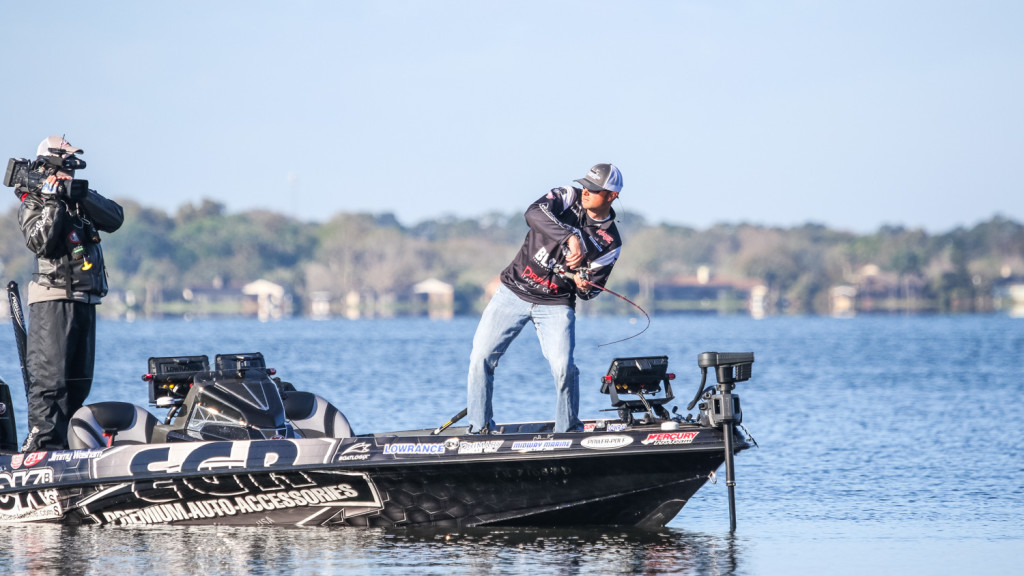
Each day of the Tackle Warehouse Pro Circuit event presented by Bad Boy Mowers on the Harris Chain of Lakes was markedly different from the day prior. Initially, pleasant February Florida weather set a solid tone for day one of the tournament, but day two was postponed due to high winds and unsafe boating conditions – and brought with it a cold front that dictated what would happen on Saturday.
While rookie Laramy Strickland (read more about his pattern here) weighed in a mega-bag of more than 31 pounds that day en route to his first Pro Circuit win, most of the field struggled a bit, and the final 30 anglers were left scrambling to figure out how to find and catch fish in the post-frontal conditions that are often so detrimental for Florida largemouths.
Championship Sunday brought beautiful weather and a lot less wind, but the weights were still down across the board thanks to four days of unstable weather that left fish coming and going. At any given time, anglers were able to find prespawn, spawning and postspawn bass all over the chain.
With the conditions so varied from day to day, it was the top 10 anglers who were most successful at making the right adjustments at the right time to find and catch the biggest bags. Here’s how they did it.
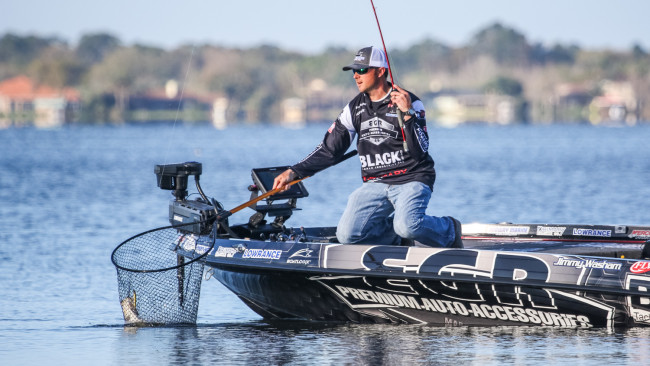
2. Washam targets grass near deep water
Pro Circuit rookie Jimmy Washam wasn’t fishing in deep water, but he needed it to catch 56-14 over the three tournament days.
“It was related to grass,” he says of his pattern. “It didn’t necessarily have to be way offshore, but it needed to be in close proximity to deep-water access.”
Essentially, Washam was looking for grass flats that bass were using as staging areas to move up to spawn or to recover from spawning. He caught a mix of both prespawn and postspawn fish over the course of three days.
“On day one and most of practice, all my fish were postspawn, but on day two, my big fish was prespawn, and that was attributed to the cold front. Likely it was so healthy it was probably ready to spawn and bailed off a bed,” he explains.
Washam spent most of his time in Dora and Beauclair targeting flats near deeper water that had a mix of both hydrilla and eelgrass on them. He says his fish primarily used the eelgrass in that mixture to stage.
To catch his fish, Washam used just one bait: a Megabass Ito Shiner jerkbait in a golden shiner color, rigged on a 6-foot, 9-inch, medium-power rod with a high-speed reel for picking up a lot of line – something he needed for working the bait fairly fast. He used 16-pound-test Sunline Super FC Sniper fluorocarbon for his jerkbait (instead of his usual 12-pound test) to allow for longer casts and to work the bait just a few feet below the surface and above the grass.
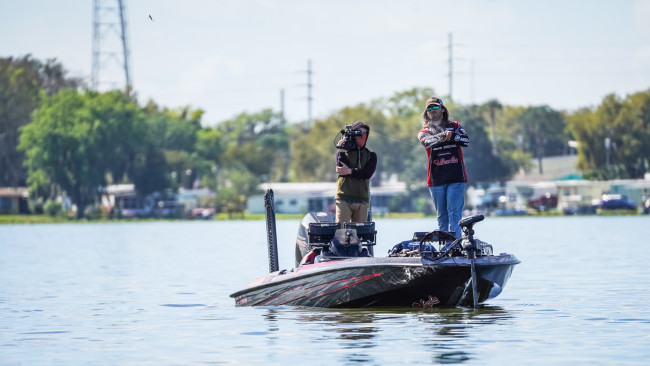
3. Freeman finds some shell
Happenstance and instinct led to Hunter Freeman finding a special spot on Lake Griffin this week, and he rode that spot for most of the tournament to a 54-6 total and third-place finish.
“I was just targeting eelgrass – isolated patches – and if it had shell around it, it made it better,” he says. “It seemed like all the big fish came off shell. The place I caught the big bag [25-14 on Saturday], I actually snagged a trap and ripped two pieces of shell up. I threw a Carolina rig out in practice and felt the shell and then actually started dialing in where the shell was.
“I saw some birds busting and went over there. That’s the only reason. I never would have stopped.”
That spot produced few fish but tons of weight for Freeman, who didn’t catch anything short of a quality largemouth (and in some cases giants) there. He spent most of Saturday on that spot and leaned on it hard to catch his three fish for 15 pounds on Sunday.
“The only place I caught big fish was on that shell bed,” he says. “I caught my kicker there the first day, and the second day I caught all my weight there. There was something to it because it kept having prespawn and postspawn fish on it.”
Freeman had other areas with grass patches, which he ran for limit-filling fish, but that one big point in Griffin was his juice all week.
To catch his fish, Freeman relied on a Carolina rig tipped with a Zee Bait Co. Rib Tail Worm in junebug. He used a 2-foot leader with a 1-ounce Swagger Tungsten weight on a Falcon Expert rod.
Freeman also caught a few fish on a sexy shad Salmo square-bill crankbait and a discontinued XCalibur One Knocker lipless crankbait, (the BOOYAH One Knocker is a similar bait) but most of his damage came on the Carolina rig.
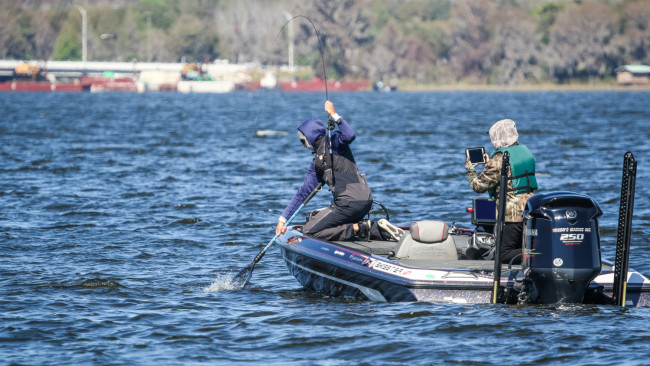
4. Gelles milks one big flat in Little Harris
It wasn’t hard to find Kyle Gelles this week. The Idaho pro, by and large, spent almost all his time fishing a giant grass flat in Little Harris, just past the 19 Bridge.
The flat was large, but there wasn’t exactly ample grass on it. The grass was just scattered enough to give Gelles something to target.
“The grass is not real heavy where I was fishing,” he explains. “What kind of clued me in to it were the birds. The fish were chasing shad, and the birds were hanging around. That’s kind of what clued me in to kind of the sweet spots out there. There are a few patches that are maybe the size of a boat those fish are hanging up on.”
That area was the only place Gelles was able to get bit in practice, and, not having anything else he was confident in, the rookie milked that flat for three days, though it dried up on Sunday and he was forced to wander a bit to catch two key kickers before weigh-in.
“I don’t know if I stuck all the fish in there,” he says. “I had a few that swiped at my bait this morning [Sunday] but just didn’t hook up. I ran down the bank and found another cove – pretty featureless, really – but the birds were hanging around. It’s just one of those little cuts back there on the outside of a spawning canal. They came up and busted a few times in front of me, and I ended up catching two.”
Gelles relied on a few baits to secure his fourth-place finish on Harris. His most productive were two jerkbaits – a Lucky Craft Pointer 100 and a Megabass Ito Vision 110, which he rigged on a 7-foot, medium-power Cashion rod and a Quantum Smoke (8.1:1 gear ratio) reel spooled with 10-pound-test Berkley Trilene 100 Percent Fluorocarbon.
He also used Keitech Swing Impact FAT swimbaits (3.8 and 5.8) in light hitch on a 3/4-ounce Dirty Jigs Matt Allen Tactical Bassin head – mostly for schooling fish – and a 1/2-ounce Z-Man ChatterBait Jack Hammer in clearwater shad with a Keitech trailer. Gelles threw the swimbaits on a 7-foot, 6-inch Alpha Angler flipping stick for long casts and hard hooksets, and he threw the ChatterBait on a fiberglass Alpha Angler rod. Both were paired with Shimano Curadoreels (7.4:1 gear ratio) spooled with 20-pound-test Berkley Trilene 100 Percent Fluorocarbon.
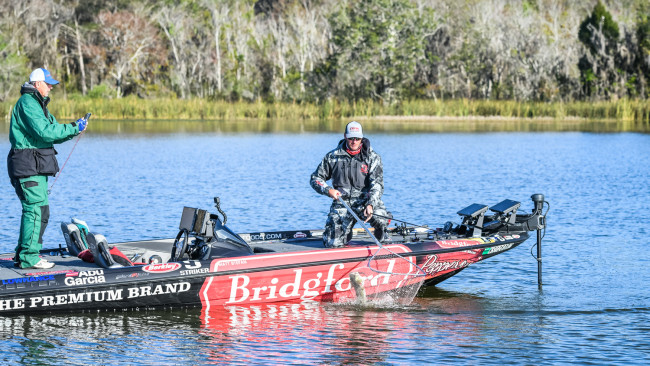
5. Stefan finds isolated shell and grass
For three days, Matt Stefan rotated between spots in Harris and Little Harris. Each spot shared a common characteristic: a mix of shell beds and grass.
“I had three actual stretches of grass, but within those stretches there was one key spot,” he says. “I had probably six other small points of weeds off the hay grass and probably 30 shell beds.”
Most of Stefan’s fish were off the edges of the grass and not tucked up inside it, which made for fairly target-specific presentations.
For the task, the Junction City, Wis., pro relied on an unpegged Texas rig with a 1/4-ounce weight and a Berkley PowerBait MaxScent The General in junebug. He threw that on an MHX 874 rod with an Abu Garcia Revo AL-F(8.0:1) spooled with 15-pound-test Berkley Trilene 100 Percent Fluorocarbon.
He also caught some key fish on a discontinued XCalibur XR50 lipless crankbait (ghost), which he yo-yoed over the shell beds.
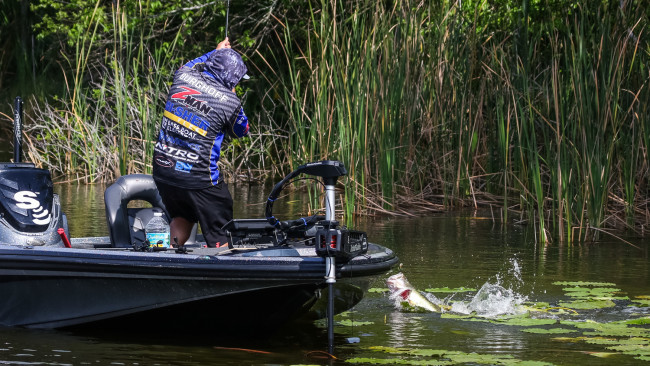
6. Burghoff flips in Apopka
While Miles Burghoff did sight-fish to catch his first bass, he never really got a look at most of his fish before he caught them – though he was definitely targeting spawning bass.
“I was flipping reeds and a mixture of emergent grass,” he says. “Primarily, it had to have cattails, and some of the best areas had some very sparse eelgrass mixed into the cattails. I was essentially fishing for spawning fish in the cattails in areas along the side of a canal.”
That canal was the Apopka Beauclair Canal, and Burghoff spent most of his time there, just above Lake Apopka, covering water and looking for areas that held multiple quality fish.
Burghoff kept it pretty simple throughout the tournament. He primarily employed a Z-Man Palmetto BugZ in a couple colors (bama bug and California craw) with either a 1/2- or 3/4-ounce weight and a Hayabusa 959WRM hook. He threw that on a 7-foot, 6-inch, heavy Fitzgerald All Purpose rod and a Fitzgerald Stunner reel spooled with 65-pound-test Seaguar Smackdown braid.
He also caught his day-one kicker – a 7-11 giant – sight-fishing a bed with a Z-Man Boar HogZ.
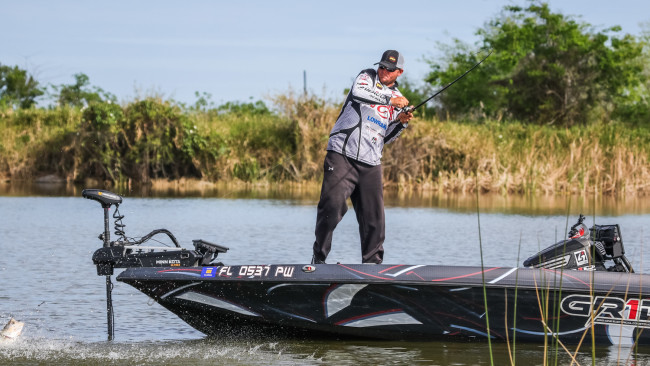
7. J-Mac makes long run into Apopka
Jared McMillan and his brother, Brandon, both made long runs to fish close to one another in Lake Apopka all three days of the tournament. Both finished in the top 10, and both were doing many of the same things.
Jared primarily targeted pencil reeds in deeper water that were growing from hard bottom, where bass were more likely to spawn. That worked for a couple days – especially on day one when he weighed in 22-1 – but the area and the pattern both dried up on Saturday and Sunday to the tune of 13-14 and 14-6, respectively.
“I just feel like I ran out of fish,” he says. “I didn’t have a lot to start with. There weren’t a lot of areas down there that I felt were right.”
Because the water in Apopka was fairly dirty compared to the rest of the Harris Chain, Jared was able to get up close to his fish without danger of spooking them. He says he only got about 10 bites a day, but he fished clean and managed to get them in the boat.
Jared rotated between a Texas-rigged Strike King KVD Perfect Plastic Ocho with a 5/8-ounce weight and a Strike King Rage Tail Craw with a 3/4-ounce weight, both in black and blue. He rigged both on 7-foot, 4-inch Team Lew’s Pro-Ti Speed Stick rods paired with Team Lew’s Pro-Ti Speed Spool SLP reels (7.5:1) spooled with 65-pound-test Strike King Tour Grade braid.
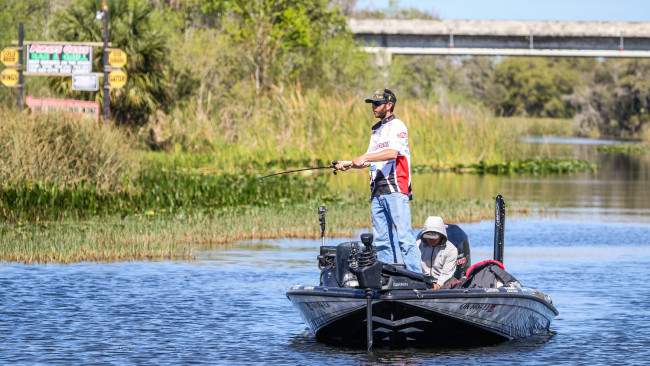
8. Warren cashes in on fry-guarder bite
With so many bass having spawned already, Chad Warren was able to effectively run a pattern centered on targeting fry-guarders near lily pads – of which Florida has a ton.
“I was fishing pads, mostly,” he says. “I think most of the fish I was catching were fry-guarders. Most of the time when I’d get a bite, there were fry shooting out of the water.”
Recognizing that fact, the Oklahoma pro opted for a bait that would elicit a reaction strike from bass guarding their young: a swim jig. That was the one bait Warren used all week, all on the same setup. Every fish he weighed in he caught on that bait.
Warren fished primarily in the river near Griffin, though he also spent some time in Harris. In both areas, he simply cast near lily pads (often overtop of them) and burned his swim jig through and around the pads looking for that reaction strike.
Warren’s swim jig of choice is a Bayou Bug Jigs 1/2-ounce model in watermelon green with a Reaction Innovations Skinny Dipper (Houdini) on Berkley X5 65-pound-test braid. He spooled that on an Abu Garcia Revo MGX (8.0:1 gear ratio) on a Falcon Cara Lizard Dragger II rod.
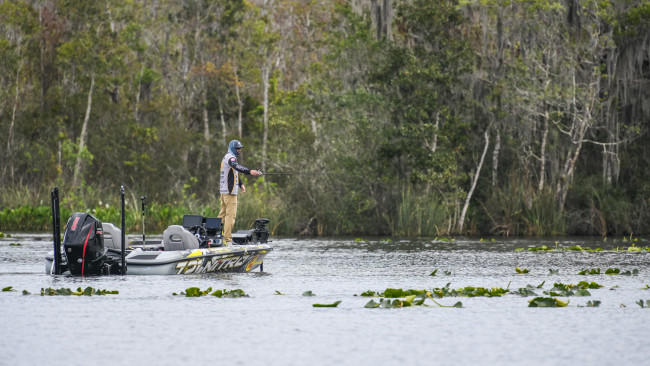
9. Scanlon zeroes in on lily pads at specific depths
Casey Scanlon cashed in a top 10 doing what many other pros did throughout the tournament: targeting lily pads. Unlike many of his competitors, though, he was primarily sticking to pads in a specific amount of water.
“As long as it was in 4 to 6 feet of water, it seemed like it was game on,” he says. “It was just more or less about being real persistent and slow.”
The pads Scanlon preferred were sparse and isolated, and he ran that pattern all through Lake Harris.
“I stayed in Harris the whole tournament,” he adds. “I bounced around. I had some areas that were better than others that I was going back to each day and picking up some fish, but it was definitely a pattern. They were situated in certain places in the pads, usually where it was a little sparser or on the points of them.”
While Scanlon caught a couple fish on a Carolina rig on “one-cast deals” at certain locations, he primarily used a black and blue Bass Pro Shops Stik-O on a 4/0 Hayabusa WRM114HD hook all three days. He fished it with a 7-foot, 6-inch, heavy Johnny Morris Signature Series rod paired with a Bass Pro Shops Johnny Morris Platinum Signature reel (8.3:1) spooled with 20-pound-test Bass Pro Shops fluorocarbon line.
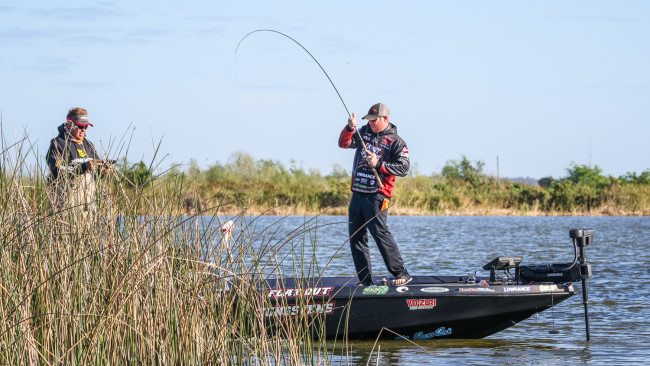
10. Big Mac sticks close to his brother
Brandon and Jared McMillan ran essentially the exact same program on the Harris Chain, both making the hour-and-a-half run to Apopka each day to get away from fishing pressure and take advantage of some prime flipping water. Jared was just able to better capitalize on some bigger bites, but both ultimately turned in top-10 finishes.
Brandon flipped around Apopka, hitting anything that looked good. For him, it wasn’t so much about types of grass or bottom composition as it was fishing with his eyes.
“I was just looking for a place I could get to the bank that had some kind of depth,” he says. “It could have been reeds. It could have been cattails. I caught them off all of it. It really wasn’t anything special. It was just kind of running around and seeing what looks good and if you could get a few bites.”
Brandon says all the fish he was targeting were spawners, and seeing pads and reeds rustling as bass were pulling up and rolling was a dead giveaway.
“They were all spawners in my opinion – every one of them,” he adds. “You could see them moving, pulling up and rolling. There’d be six or eight of them in one patch. You could see them. They’d give themselves away.”
Unfortunately, Brandon’s fish got a little finnicky as the tournament progressed, and getting them to bite got harder and harder. On Sunday, Brandon says he caught 12 fish but saw about 30 more he should have been able to catch, and maybe would have earlier in the tournament.
Because of wind conditions, Brandon alternated between a few different weight sizes on his Texas rig (1/2-, 3/4- and 1-ounce Flat Out Tungsten) with a 4/0 Mustad hook threaded with several different colors of Bruiser Baits MacDaddy Craws. He threw that on a 7-foot, 5-inch G. Loomis GLX rod with a Shimano Metanium (8.5:1) reel and 60-pound-test Gamma Torque braid.